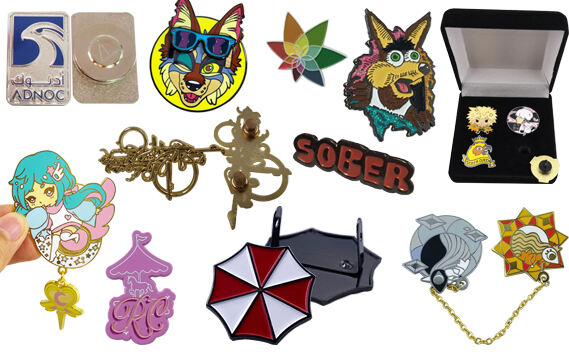In today's interconnected world, badges have evolved far beyond simple identification tools to become powerful symbols of achievement, membership, and professional recognition. From corporate environments to educational institutions, digital platforms to community organizations, badges serve multiple purposes that extend well into modern society's fabric. Understanding the diverse applications of these versatile items reveals their enduring relevance and growing importance across various sectors.
The transformation of badge usage reflects broader changes in how we communicate identity, demonstrate competence, and build communities. Modern badges incorporate advanced materials, sophisticated design elements, and even digital technologies that enhance their functionality and appeal. This comprehensive exploration examines the most prevalent applications of badges in contemporary settings, highlighting their significance across different industries and contexts.
Corporate and Professional Identity Applications
Employee Identification and Security
Corporate environments rely heavily on employee identification badges for security and operational efficiency. These essential tools enable organizations to control access to sensitive areas, track employee movements, and maintain comprehensive security protocols. Modern workplace badges often incorporate RFID technology, magnetic strips, or smart chip capabilities that integrate with building security systems and time-tracking software.
Beyond basic identification, employee badges serve as professional branding tools that reinforce company culture and visual identity. Organizations customize these items with corporate logos, color schemes, and design elements that align with their brand guidelines. The visual consistency achieved through standardized badge designs contributes to a cohesive professional environment while ensuring easy recognition of authorized personnel.
Professional Recognition and Achievement
Recognition programs within corporations frequently utilize badges to acknowledge employee achievements, milestones, and exceptional performance. These recognition badges create tangible symbols of accomplishment that employees can display proudly, fostering motivation and reinforcing positive workplace behaviors. Companies design specialized badges for various achievements such as years of service, safety records, sales targets, or innovation contributions.
The psychological impact of receiving recognition badges extends beyond individual satisfaction to influence team dynamics and organizational culture. Employees who receive achievement badges often experience increased job satisfaction and engagement, while their colleagues witness tangible evidence of the company's commitment to recognizing excellence. This visible recognition system encourages healthy competition and continuous improvement across the organization.
Educational and Academic Recognition Systems
Student Achievement and Merit Recognition
Educational institutions have long utilized badges to recognize student achievements, academic excellence, and participation in various activities. School badges serve multiple functions, from identifying students as members of specific institutions to acknowledging particular accomplishments in academics, sports, or extracurricular activities. These recognition tools help create a sense of pride and belonging among students while motivating continued excellence.
Modern educational badges often reflect specialized programs, honor societies, or leadership positions that students have earned through dedication and hard work. Schools design unique badges for different achievement levels, creating a hierarchical system that encourages students to strive for higher recognition. The visual nature of these awards makes them particularly effective in school environments where peer recognition plays a crucial role in student motivation.
Digital Learning and Certification Programs
The rise of online education and professional development programs has introduced digital badges as alternatives to traditional certificates and diplomas. These digital credentials provide verifiable proof of skill acquisition, course completion, and competency achievement in various subjects. Educational platforms, universities, and professional organizations increasingly adopt digital badge systems to credential learning outcomes and facilitate career development.
Digital badges offer advantages over traditional credentials through their portability, verifiability, and granular representation of specific skills and knowledge areas. Learners can display these credentials on professional networking platforms, include them in job applications, and use them to demonstrate continuous learning and professional development. The metadata embedded in digital badges provides detailed information about the issuing organization, requirements for earning the badge, and evidence of the holder's competency.

Community and Social Organization Applications
Membership Identification and Group Affiliation
Community organizations, clubs, and social groups utilize badges to identify members and demonstrate group affiliation. These identification tools help create visual cohesion within groups while enabling easy recognition of members during events, meetings, and public activities. Membership badges often incorporate organization logos, colors, and symbols that represent the group's values and mission.
The design of membership badges frequently reflects the organization's history, traditions, and cultural significance. Established organizations may use badge designs that have evolved over decades, creating a sense of continuity and tradition among members. These visual identifiers strengthen group identity and foster a sense of belonging that extends beyond individual participation to encompass broader community connections.
Volunteer Recognition and Service Awards
Volunteer organizations extensively use badges to recognize service contributions, commemorate special events, and acknowledge various levels of volunteer commitment. These recognition systems help maintain volunteer motivation by providing tangible acknowledgment of their efforts and contributions to community causes. Service badges often indicate the number of hours volunteered, types of service provided, or leadership roles assumed within the organization.
The ceremonial aspect of badge presentation adds significance to volunteer recognition programs, creating memorable experiences that reinforce the value of community service. Organizations often design special commemorative badges for milestone events, fundraising campaigns, or disaster response efforts, creating lasting mementos that volunteers can treasure as symbols of their meaningful contributions to society.
Law Enforcement and Public Safety Applications
Authority and Jurisdiction Identification
Law enforcement agencies rely on badges as fundamental symbols of authority and official identification. Police badges serve multiple critical functions, including establishing officer credibility, indicating rank and jurisdiction, and providing immediate visual identification in various situations. The design and manufacturing of law enforcement badges adhere to strict standards and security measures to prevent counterfeiting and unauthorized use.
The symbolic power of law enforcement badges extends beyond mere identification to represent the authority vested in officers by society. These items carry significant legal and cultural weight, serving as visible reminders of the responsibilities and powers entrusted to law enforcement personnel. The tradition and ceremony surrounding badge presentation to new officers emphasize the solemnity and importance of their commitment to public service.
Emergency Services and First Responder Recognition
Emergency services organizations, including fire departments, emergency medical services, and disaster response teams, utilize badges for identification, rank designation, and recognition of service excellence. These specialized badges help establish authority during emergency situations while providing clear identification of qualified personnel to the public and other emergency responders.
Recognition badges within emergency services often commemorate heroic actions, years of service, or specialized training achievements. These awards serve important morale and retention functions within organizations that face high-stress situations and personal risk. The presentation of commendation badges provides formal recognition of exceptional service while inspiring continued dedication to public safety missions.
Sports and Recreation Recognition Systems
Athletic Achievement and Competition Awards
Sports organizations at all levels use badges to recognize athletic achievements, team participation, and competitive excellence. Youth sports programs particularly benefit from badge systems that acknowledge improvement, sportsmanship, and team contribution beyond traditional winning and losing metrics. These recognition tools help maintain participant motivation and emphasize the value of personal growth and team cooperation.
Professional and amateur sports leagues often create commemorative badges for special events, championship competitions, and milestone achievements. Athletes and fans collect these items as mementos of significant sporting moments, creating lasting connections to memorable experiences. The collectible nature of sports badges adds an additional dimension to their appeal and significance within athletic communities.
Recreational Activity Certification
Recreational organizations issue badges to certify completion of safety courses, skill development programs, and activity-specific training requirements. Outdoor recreation activities such as hiking, camping, and water sports often require participants to demonstrate competency through badge-earning programs that ensure safety and environmental stewardship.
These certification badges serve practical purposes by indicating that holders have acquired necessary knowledge and skills for safe participation in potentially hazardous activities. The credentialing aspect of recreational badges provides reassurance to activity organizers, participants, and insurance providers while promoting responsible recreation practices and environmental conservation.
FAQ
What materials are commonly used for modern badge manufacturing
Modern badges are manufactured using diverse materials including metal alloys, enamel, plastic composites, and digital printing substrates. High-quality badges often feature brass, copper, or zinc alloy bases with enamel fills, while budget-friendly options may use printed plastics or fabric materials. Advanced manufacturing techniques enable the incorporation of special features such as holographic elements, RFID chips, and color-changing inks.
How do digital badges differ from traditional physical badges
Digital badges exist as electronic credentials that can be shared online, verified through blockchain technology, and contain detailed metadata about achievements and issuing organizations. Unlike physical badges, digital versions can be easily duplicated for sharing, include links to evidence of accomplishment, and provide real-time verification of authenticity through secure online systems.
What security features prevent badge counterfeiting
Anti-counterfeiting measures for badges include specialized manufacturing techniques, unique serial numbers, holographic elements, and proprietary materials that are difficult to replicate. High-security badges may incorporate microprinting, color-changing inks, embedded chips, or other technologies that enable authentication and prevent unauthorized reproduction.
How should organizations design effective badge recognition programs
Effective badge programs require clear criteria for earning recognition, meaningful design elements that reflect organizational values, and consistent presentation ceremonies that emphasize the significance of achievements. Organizations should establish multiple recognition levels, ensure fair and transparent award processes, and regularly review program effectiveness to maintain participant engagement and motivation.




